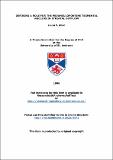Files in this item
Defining a role for the peduncolopontine tegmental nucleus in striatal outflow
Item metadata
| dc.contributor.advisor | Winn, Philip | |
| dc.contributor.author | Allen, Laura F. | |
| dc.coverage.spatial | 305 | en_US |
| dc.date.accessioned | 2012-06-07T08:35:22Z | |
| dc.date.available | 2012-06-07T08:35:22Z | |
| dc.date.issued | 1996 | |
| dc.identifier.uri | https://hdl.handle.net/10023/2673 | |
| dc.description.abstract | The pedunculopontine tegmental nucleus (PPTg) lies within the pontomesencephalon and contains cholinergic and non-cholinergic neurones. It has extensive afferent and efferent connections throughout the brain. Early research suggested a role for the PPTg in the mediation of locomotor activity, and it was believed to form the major substrate of the electrophysiologically identified mesencephalic locomotor region (rviLR). Studies using selective excitotoxic lesions of the PPTg demonstrated that it has no role in the mediation of spontaneous or nucleus accumbens-induced (NAcc) locomotion. However evidence has suggested that the cuneiform nucleus (CNF) and not the PPTg is the main locus of the .MLR. The effects of bilateral ibotenate CNF lesions on spontaneous and amphetamine-induced locomotion stimulated from the NAcc were therefore investigated. CNF lesions had no effect on either type of locomotor activity. Bilateral ibotenate lesions of the PPTg have been shown to influence the expression of orofacial stereotypies following administration of systemic amphetamine. Oral stereotypies can be elicited reliably by direct stimulation of the ventrolateral caudate-putamen (VLCP). This thesis sought to clarify the role of the PPTg in the mediation of oral stereotypies, by combining bilateral ibotenate lesions of the PPTg with direct microinjection of amphetamine into the VLCP. Lesions of the PPTg caused a shift in the dose response curve to amphetamine resulting in an increase in the incidence and intensity of oro facial stereotypies at lower doses. Thus the PPTg appears to have inhibitory control over the expression of orofacial behaviors. It is hypothesised that while neither the PPTg nor the CNF have a role in the mediation of locomotor activity per se they may provide an integrative functional role, which influences motor outflow. The role of the CNF in the transmission of nociception and a role for the PPTg in the mediation of striatal outflow is discussed. | en_US |
| dc.language.iso | en | en_US |
| dc.publisher | University of St Andrews | |
| dc.subject.lcc | QP383.7A6 | |
| dc.subject.lcsh | Hypothalamus | en_US |
| dc.subject.lcsh | Brain--Localization of functions | en_US |
| dc.title | Defining a role for the peduncolopontine tegmental nucleus in striatal outflow | en_US |
| dc.type | Thesis | en_US |
| dc.type.qualificationlevel | Doctoral | en_US |
| dc.type.qualificationname | PhD Doctor of Philosophy | en_US |
| dc.publisher.institution | The University of St Andrews | en_US |
This item appears in the following Collection(s)
Items in the St Andrews Research Repository are protected by copyright, with all rights reserved, unless otherwise indicated.

